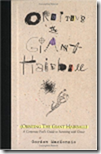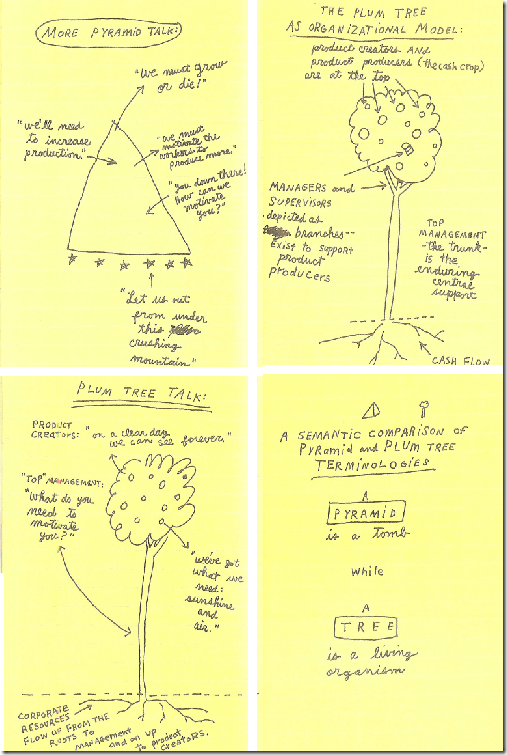Author: Gordon MacKenzie
ISBN-10: 0670879835
ISBN-13: 978-0670879830
 From the title, I had this book all wrong. Gordon MacKenzie successfully tells us how to survive the natural gravity of the Giant Hairball that sucks the life out of creativity, innovation, and the very people that corporate entities require to stay vital and in demand. Once read, the full title: ”Orbiting the Giant Hairball: A Corporate Fool’s Guide to Surviving with Grace,”makes sense.
From the title, I had this book all wrong. Gordon MacKenzie successfully tells us how to survive the natural gravity of the Giant Hairball that sucks the life out of creativity, innovation, and the very people that corporate entities require to stay vital and in demand. Once read, the full title: ”Orbiting the Giant Hairball: A Corporate Fool’s Guide to Surviving with Grace,”makes sense.
I had this book on my reading list for over a year. I had listened to a lecture held at the University of Illinois on innovation and leadership by David Markham, President of Commercial Launch at Lockheed Martin Space, where David suggested that this book was the one thing to take away.
Background
As an artist and creative type, the author seems like an unlikely source for this thinking, but then, he is the exact perfect source, when you consider that Gordon resisted the natural gravitational pull of the corporate giant hairball to stay vibrant, creative, and lead creativity in teams that exceeded traditional norms and expectations for corporate organizational and productivity DNA.
MacKenzie early in the book describes how society, family and corporations shame us to first deny and then squelch and kill our own creative spirit. He describes how the disrupters and the malcontents are often labeled such because they do not conform and after shaming them fails to get them in line, they are shunned, left out, and ignored. How horrible to think that this is the natural transition that structure, leadership and traditional human resources administrative approaches drive organizations to become absolutely irrelevant.
Even though the book is about MacKenzie’s time at Hallmark (the greeting card company) over 30 years, it’s easy to look around and see contemporary examples (e.g., irrelevant and decaying: Sears/Kmart vs. relevant and growing: Amazon). We have not yet fully learned and committed to the lessons Gordon has shared.
Looking at other’s reviews, it’s clear that people either get this book or reject it. Since the book was first published in 1998 perhaps we weren’t ready for it – but now with innovation and creativity at the heart of true economic recovery (and after four years of tweaking, the budget-cutters, and efficiency-mongers are no longer able to find an effective knob to turn) perhaps Boards, CEOs and other stewards will see the vision in this book and reconstruct their organizations to change.
Some Points On The Corporate Giant Hairball
Many have read this book and commented on critical points it makes in terms of what it takes to innovate, what kills creativity and innovation and so on. I want to call out a few points from the book that add to my recommendation that this book is valuable for you.
Creative Games in Education– Gordon recalls visiting schools, where kids are shamed into conforming, he states: “Every school I visited was participating in the suppression of creative genius.” How horrible to think of how many Einstein’s and Picasso’s have been destroyed this way. Worse, we are programmed by our environment to wait for someone in authority to give us permission to “be creative.” This permission never comes. Surely you recall this happening to you in grade school?
Corporate Normalcy – In the business world, we have ancient-structured pyramidal organizations with top-down command and control structures, and the people taking administrative authority and which we call “leaders” build the giant hairball ensuring no room for original thinkingor primary creativity. Every role is driven by a job description, and no matter how obvious it is that a better way exists, any employee that raises her hand is considered to be challenging authority and threatens the “leader,” so the status quo is propagated. You’ve seen this in your own organizations, right?
Traditional Models – The use of models is over-emphasized as a way to make decisions in a world of infinite reality. Gordon shares that if we over-use models, everything will look the same– like something we already have or have experienced. We choose, or make decisions, based on the model because it is known and safe. But, models do not leave room for creativity or the opportunity to push into new spaces or our infinite reality and try something radically different that could perhaps be far greater. The forced application of spreadsheet decision analytics leaves no room for “CEO gut feel” for the team.
Pyramidal Org Charts vs. the Plum Tree– Perhaps the best chapter uncovers the compare-and-contrast analysis between the life-sucking pyramidal organization that roles up to a single point at the top, with Gordon’s Plum Tree description. Seeing the nurturing and growing support of a root system and tree trunk of management to enable employees in the leaves of the tree to produce fruit is an effective way of seeing what will drive innovation – if the company’s leadership has the will. The following four pages copied from the book makes this concept plain and simple.
This book is rich with stories that everyone will understand. So many more than I can include in my review today. Buy the book and carve out 2 hours to read and enjoy it. Then give it to someone else so they too can grow from it.
More Pondering
This is an easy book, written clearly, and in brief. I’ve recommended it to my college-aged kids so they can recognize the giant hairball and work to avoid becoming ensnared by it. I wish I had read it when I was younger. One chapter even has one single sentence. Then there is the chapter that is a complete hand-written sketchbook of thought. Everyone can learn from these concepts– if they are ready.
I have David Markham to thank for exposing me to this book. And, I hope that I can be thanked by one of you, who after reading this review, are compelled to read the 224 pages – lots of figures and sketches – that takes only a couple of hours to read and absorb its simple and easy message. Just open your mind and the book and let go.
Please leave a comment. If you read the book, please come back and tell me what you think.
Image Credits: Gordon MacKenzie from the book.











I love, love this book. Read it during my Marketing Management class in college for my BS. I am now a manager at a fortune 500 company, the youngest manager at my company I might add and am assigning all my employees to read it as well. This form of thinking has propelled my career and will do wonders for my department.
[…] Andrew Stein […]
This is one of my all time favorite books. I read it a few years ago and it helped me to stay grounded in Corporate America, as well as, helped me to assist my clients to take necessary calculated risks to keep their businesses and careers thriving.
Thank you Laura for your thought. I am amazed at the number of people that know of this book – and how much it has applied, or they have learned. Clearly should be on everyone’s reading list in corporate America, from the top down
Andrew, I am always impressed by how you add valuable insights when you do book reviews. Keep them coming, please.